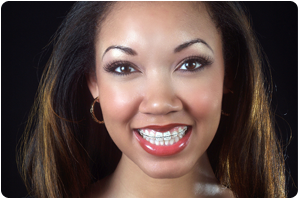Archwire
A wire engaged in orthodontic attachments, affixed to the crowns of two or more teeth and capable of causing or guiding tooth movement.
Band (orthodontic)
A thin metal ring, usually stainless steel, serves to secure orthodontic attachments to a tooth. The band, with orthodontic attachments welded or soldered to it, is closely adapted to fit the contours of the tooth and then cemented into place.
Bracket
An orthodontic attachment that is secured to a tooth (either by bonding or banding) for the purpose of engaging an archwire. Brackets can be fabricated from metal, ceramic, or plastic.
Ceramic brackets
Crystalline, alumina, tooth-shade, or clear synthetic sapphire brackets that are aesthetically more attractive than conventional metal attachments.
Crowding
Dental malalignment caused by inadequate space for the teeth.
Debanding/debonding
The removal of cemented orthodontic bands or bonded brackets.
Elastics (rubber bands)
Used to move teeth in prescribed direction (commonly connected to molar band and upper ball hook). Found in numerous colors for a better appearance.
Gingiva
The tissue that surrounds the teeth, consisting of fibrous tissue that is continuous with the periodontal ligament and mucosal covering.
Headgear
The generic term for extraoral traction (attached around the backside of the head) for growth modification, tooth movement, and anchorage.
Imaging
The process of acquiring representations of structures in either two or three dimensions.
Lingual
Of or pertaining to the tongue. A term used to describe surfaces and directions toward the tongue.
Lingual appliances
Orthodontic appliances fixed to the lingual surface of the teeth.
Maxillary
Of or pertaining to the upper jaw. May be used to describe teeth, dental restorations, orthodontic appliances, or facial structures.
Orthodontist
A dental specialist who has completed an advanced post-doctoral course, accredited by the American Dental Association, of at least two academic years in the special area of orthodontics.
Orthognathic surgery
Surgery to alter relationships of teeth and/or supporting bones, usually accomplished in conjunction with orthodontic therapy.
Overbite
Vertical overlapping of upper teeth over lower teeth usually measured perpendicular to the occlusal plane.
Radiograph
A permanent image, typically on film, produced by ionizing radiation. Sometimes called an X-ray after the most common source of image-producing radiation.
Retainer
Any orthodontic appliance, fixed or removable, used to maintain the position of the teeth following corrective treatment.
Retention
The passive treatment period following active orthodontic correction during which retaining appliances may be used.
Straight wire appliance
A variation of the edgewise appliance in which brackets are angulated to minimize multiple archwire bends. Brackets and molar tubes have specific orientations in three planes of space.






